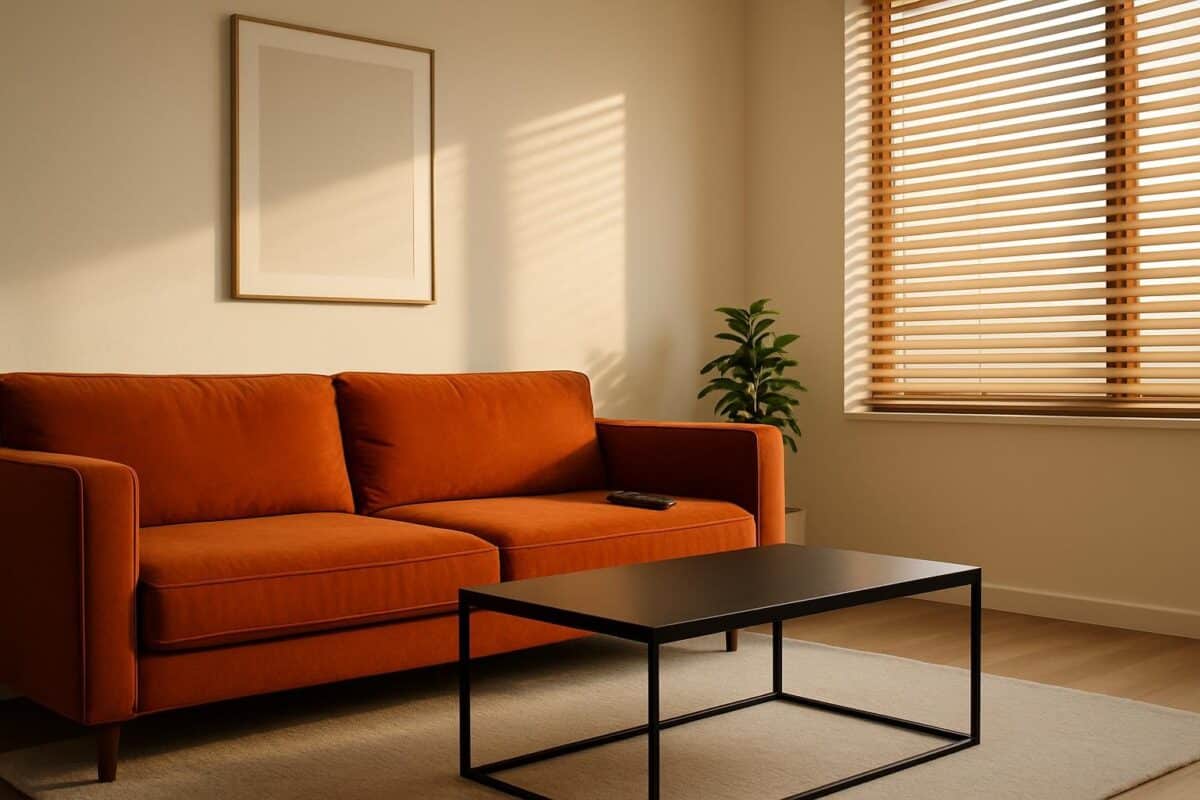Alabaster has become a favorite choice for living rooms because it offers warmth without feeling too stark or too yellow. Its soft off-white tone creates a versatile backdrop that works with both bold and subtle furniture choices. Alabaster makes a living room feel comfortable and stylish while allowing color, texture, and light to stand out naturally.
This balanced shade pairs well with deep greens, rich blues, earthy rusts, and even darker neutrals, making it easy to create a space that feels inviting at any time of day. Whether paired with natural wood, soft textiles, or metallic accents, it adapts to different design styles without losing its calming effect.
By exploring how Alabaster interacts with different sofa colors and lighting conditions, it becomes clear why so many choose it for everyday living spaces. Each combination highlights a different mood, from cozy evening warmth to crisp daytime brightness, showing the flexibility of this timeless color.
Forest Green Sofa In Warm Evening Light
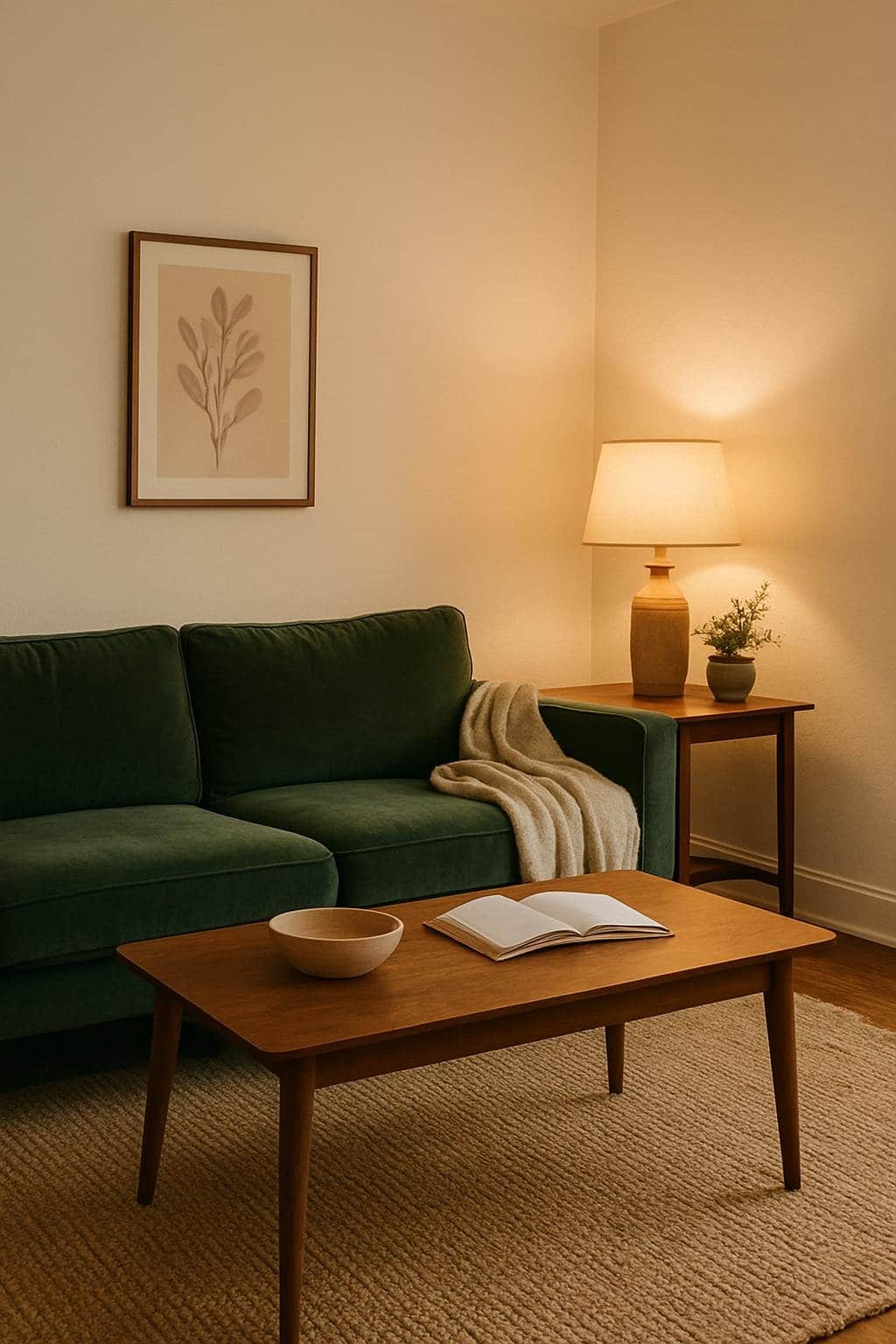
A deep green sofa grounds the room with color and presence, while natural textures and warm lighting soften the space. The combination of earthy materials and subtle shadows creates balance between comfort and style.
Forest Green Sofa Anchors The Space
A forest green sofa introduces depth and contrast against alabaster walls. Its rich tone draws the eye and becomes the natural focal point of the room.
The sofa works especially well when paired with neutral accessories such as beige cushions, cream throws, or light wood furniture. This pairing prevents the green from feeling too heavy and keeps the room visually balanced.
Placement matters. Centering the sofa across from a fireplace or beneath a large window helps establish symmetry. If the room is smaller, choosing a streamlined silhouette with slim arms and tapered legs avoids bulk while still providing presence.
For materials, velvet enhances the richness of the green, while linen or cotton blends make the sofa more casual. Both options pair well with alabaster walls, but the choice depends on whether the space leans formal or relaxed.
Jute Rug Adds Texture
A jute rug introduces natural fiber texture that complements both the sofa and the pale backdrop. Its subtle weave softens hard flooring and adds warmth underfoot without competing with the boldness of the sofa.
Because jute rugs come in neutral shades, they help bridge the contrast between dark green upholstery and light walls. This grounding effect makes the seating area feel cohesive.
Size is important. A rug large enough to fit under the front legs of the sofa and chairs creates a defined seating zone. Smaller rugs can look disconnected, while oversized rugs may overwhelm the space.
For maintenance, jute is durable but not ideal in damp areas. Pairing it with a rug pad helps with comfort and prevents slipping. Adding a secondary textile, such as a wool throw or patterned cushion, brings softness to balance jute’s coarse texture.
Evening Lamp Light Creates Cozy Shadows
Warm lamp light in the evening changes the atmosphere of the room. Instead of relying on overhead fixtures, placing table lamps or floor lamps near the sofa creates pools of light that highlight textures and colors.
The green fabric takes on a softer tone under warm bulbs, while alabaster walls reflect the glow, keeping the room bright without harshness. Shadows from the sofa and rug add depth, giving the space a layered look.
Lamp placement matters. A floor lamp angled toward the sofa provides reading light, while a smaller table lamp on a side table adds ambient glow. Choosing shades in linen or parchment diffuses the light evenly.
For consistency, use 2700K to 3000K bulbs, which produce a warm white light. This range enhances natural materials like jute and wood, while also keeping the forest green sofa rich and inviting in the evening.
Navy Sofa Against Cream Curtains
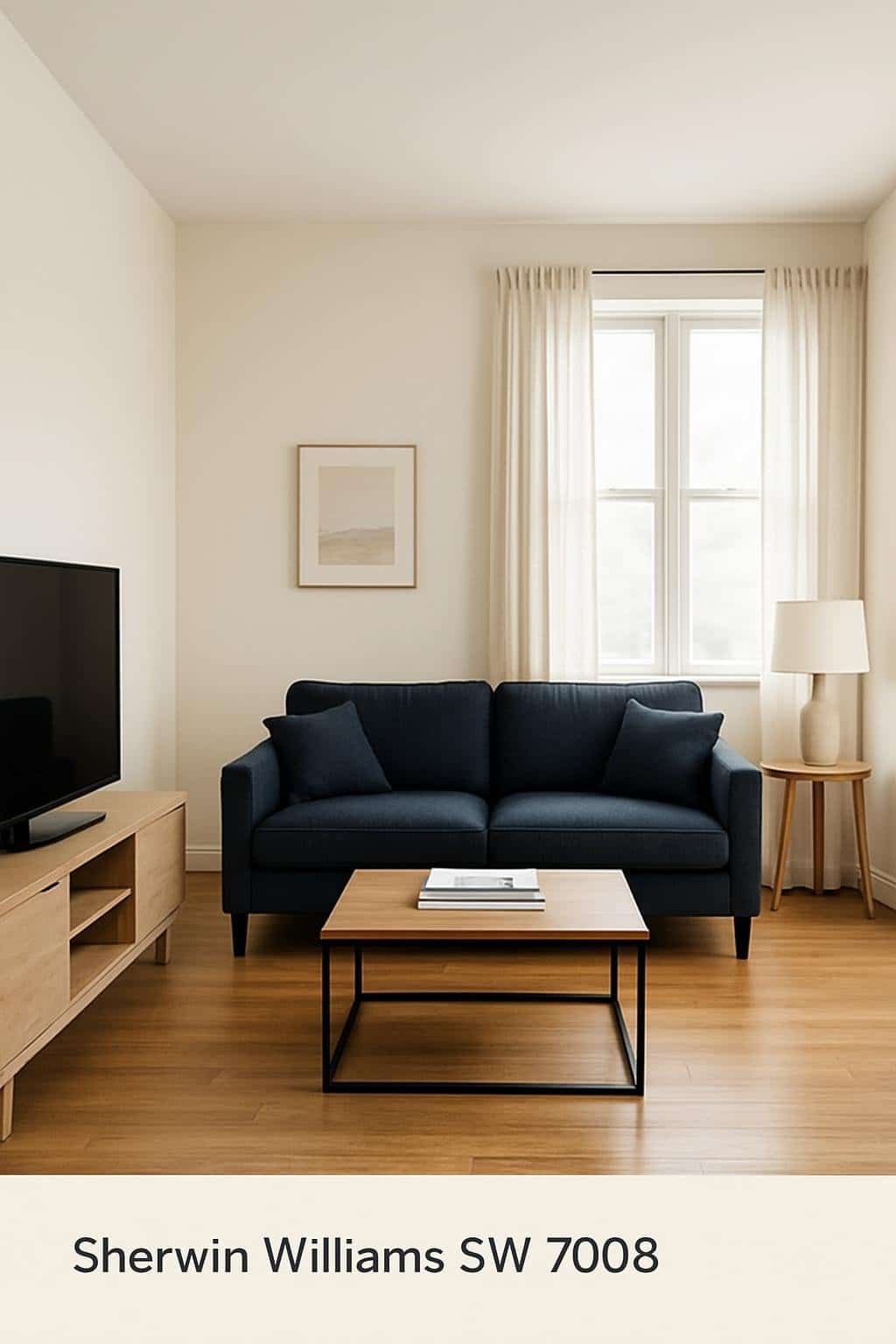
A navy sofa paired with cream curtains creates a balanced look that feels both grounded and airy. The dark seating anchors the space, while the light drapery softens the walls and filters natural light for a comfortable atmosphere.
Navy Sofa Pops Against Cream Curtains
The deep navy tone naturally contrasts with cream, making the sofa stand out as a focal point. This contrast works especially well in living rooms where the goal is to highlight the main seating area without overwhelming the space.
Cream curtains frame the sofa with a lighter backdrop, preventing the room from feeling heavy. Unlike stark white, cream adds warmth and avoids sharp contrasts that might feel too formal.
To tie the look together, accessories such as beige throw pillows, brass lamps, or a woven rug can bridge the gap between the two tones. This creates a layered palette that feels cohesive.
By keeping surrounding walls in soft neutrals like alabaster or warm white, the navy sofa maintains its prominence while still blending smoothly with the rest of the room.
Oak Floors Warm The Palette
Oak flooring introduces a natural warmth that balances the cool undertones of navy. The golden and honey shades of oak prevent the room from leaning too cold, which can sometimes happen with darker furniture.
This combination also adds texture. The smooth upholstery of the sofa contrasts with the grain of the wood, creating visual depth. A matte or satin finish on the floors works best, as it avoids glare while still reflecting enough light to brighten the space.
For added harmony, small oak details—such as a coffee table, sideboard, or picture frames—can echo the flooring. This repetition helps the room feel intentional rather than pieced together.
The result is a palette that blends cool navy, soft cream, and warm oak, offering comfort without losing elegance.
Cloudy Daylight Brightens The Room
Natural light plays a key role in how navy and cream interact. On cloudy days, cream curtains filter diffused light, softening shadows and preventing the navy sofa from appearing overly dark.
Sheer or semi-sheer curtain fabrics work especially well, allowing light to pass through while maintaining privacy. This makes the room feel open even when sunlight is limited.
Positioning the sofa near a window enhances the effect. The navy fabric absorbs some of the light, creating a cozy yet balanced look. Meanwhile, the cream curtains bounce light back into the room, ensuring the space never feels dim.
If extra brightness is needed, brushed nickel floor lamps or warm LED bulbs can supplement daylight without clashing with the natural tones already present.
Rust Sofa With Golden Hour Shadows

A rust-colored sofa introduces warmth and depth to a living room, while dark accents and natural light sharpen its presence. The combination of earthy tones, contrasting furniture, and shifting daylight creates a space that feels both inviting and visually structured.
Rust Sofa Adds Earthy Vibrance
A rust sofa grounds the room with a tone that blends the strength of red, the stability of brown, and the energy of orange. This balance makes it versatile, pairing well with both neutral walls and bolder accents.
The fabric choice changes the effect. Velvet emphasizes richness and texture, while linen or cotton blends keep the look casual and breathable. In either case, the color reads as warm and approachable.
Rust works especially well in alabaster-themed rooms because it prevents the space from feeling too pale or sterile. The contrast introduces an earthy vibrance that softens the brightness of white walls.
Designers often use rust as a focal point in living rooms. A single sofa in this shade can anchor the space without overwhelming it, allowing other furniture and decor to remain understated.
Black Coffee Table Sharpens The Design
Pairing a rust sofa with a black coffee table creates a clear visual anchor. The dark surface introduces definition, preventing the room from leaning too soft or muted.
This contrast works best with simple, structured shapes. A rectangular or round table in matte black metal or wood provides balance without competing for attention.
The pairing also supports layering. A black table allows lighter accessories—such as alabaster ceramics, glass trays, or neutral books—to stand out. This layered effect makes the room feel curated rather than cluttered.
For practical use, black surfaces are forgiving with daily wear. Minor scratches or marks are less noticeable, making the table both functional and visually sharp in a high-traffic living space.
Golden Hour Light Creates Dramatic Shadows
Natural light during the late afternoon enhances the depth of rust tones. When sunlight filters through the windows, the sofa surface shifts between deep red-browns and glowing orange highlights.
These variations create a dynamic backdrop that changes throughout the day. The effect is most pronounced on textured fabrics like velvet, where shadows and highlights play across the surface.
Golden hour also casts elongated shadows from the coffee table and surrounding furniture. This adds dimension to the room, making the arrangement appear more sculptural.
Positioning the sofa near a west-facing window maximizes this effect. Even in minimalist spaces, the interaction between rust upholstery and warm light introduces movement and subtle drama without the need for additional decor.
Beige Sectional And Wine Glass Glow
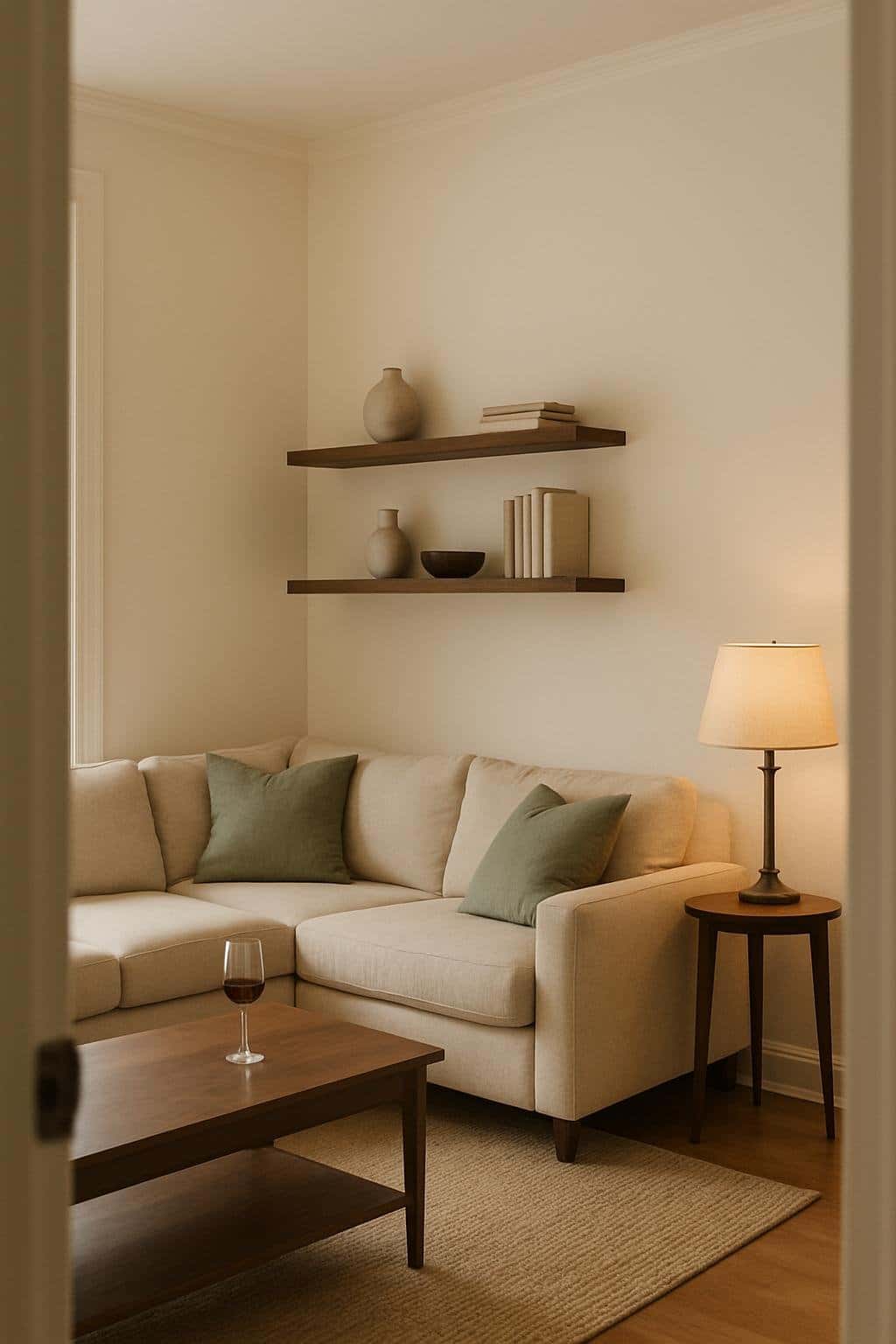
A beige sectional anchors the room with calm tones, while natural wood and layered lighting add depth and warmth. Soft seating, rich shelving, and subtle lamp light create a space that feels both functional and inviting.
Beige Sectional Keeps The Palette Soft
A beige sectional works as a neutral base that balances color and texture in the living room. Its understated tone allows other design elements—such as rugs, pillows, or art—to stand out without overwhelming the space.
This type of sofa also adapts well to different styles. It can pair with modern clean lines, transitional blends, or more traditional accents. By choosing a sectional in beige, homeowners gain flexibility to refresh the look simply by changing smaller accessories.
Practicality matters too. A sectional provides ample seating for family gatherings or casual evenings with friends. Neutral upholstery also tends to age gracefully, making it easier to maintain a consistent look over time.
Key benefits of a beige sectional:
- Neutral backdrop for seasonal decor
- Works with both warm and cool tones
- Provides versatile seating options
Walnut Shelving Adds Richness
Walnut shelving introduces contrast that prevents the room from feeling flat. Its darker grain and natural variation add depth against the lighter sectional. The shift in tone creates balance, grounding the space with a sense of structure.
Shelving also provides function. Open shelves can display books, ceramics, or glassware, while closed cabinets hide items that don’t need to be seen. This mix of display and storage keeps the room organized without sacrificing style.
Pairing walnut with beige highlights the best qualities of both. The sectional feels softer next to the wood, while the shelving looks more refined when set against a lighter seating area. Together, they create a layered palette that feels complete.
Evening Lamp Light Highlights Lived-In Details
Lamp light in the evening changes how the room is experienced. Instead of relying only on overhead fixtures, table and floor lamps create softer pools of light that emphasize texture and detail.
A linen shade can cast a warm glow over the sectional, while a directional lamp can highlight a shelf or artwork. This layered approach makes the room more adaptable, shifting from bright daytime use to a relaxed evening setting.
The glow also enhances the tactile quality of materials. Fabric weaves, wood grains, and even the curve of a wine glass become more noticeable under softer light. This subtle detail helps the space feel comfortable and lived-in without adding clutter.
Charcoal Sofa
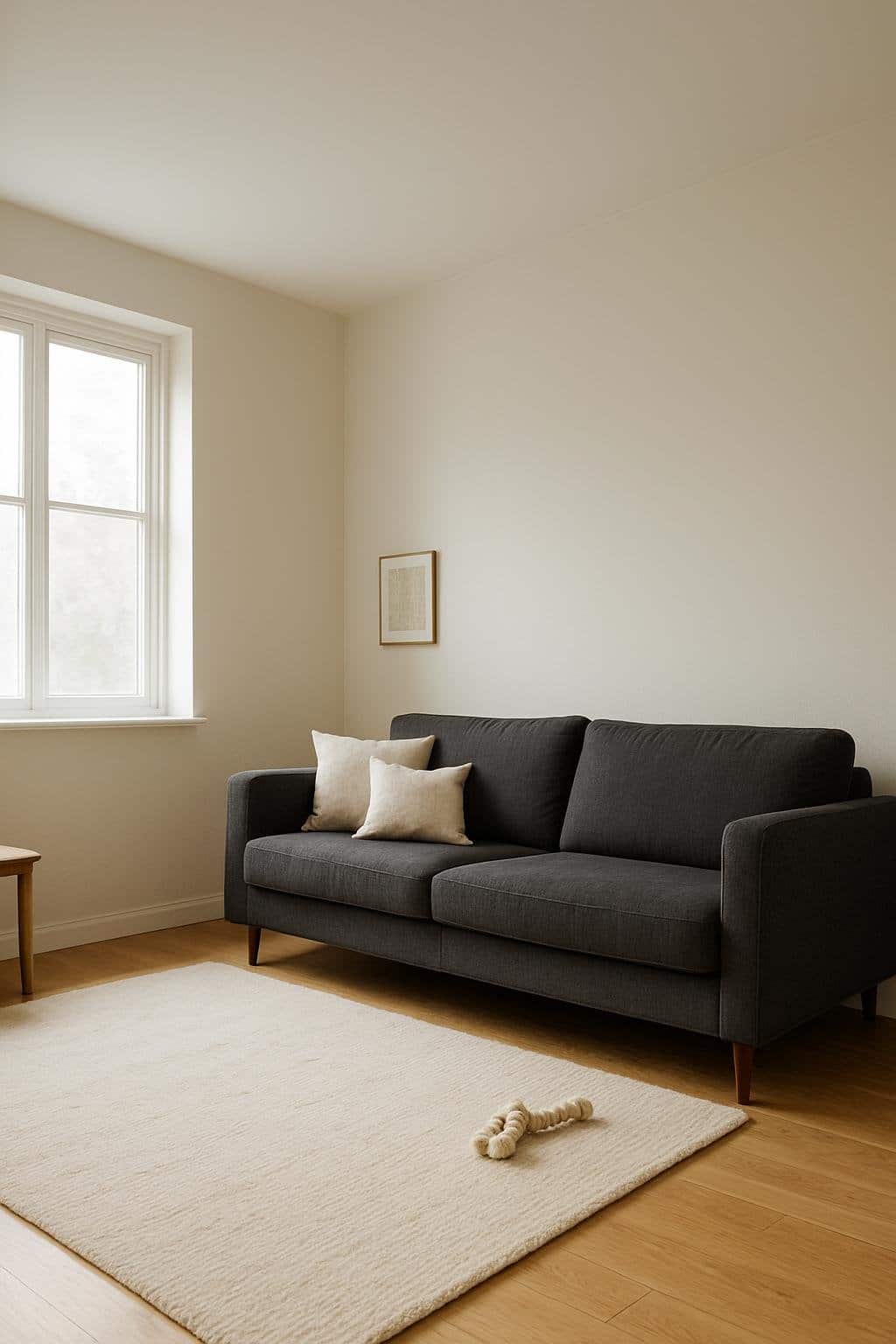
A charcoal sofa introduces depth to an alabaster-toned living room, balancing brightness with a steady anchor. Its neutral base works well with soft layers, natural light, and subtle contrasts that create a setting both functional and visually calm.
Charcoal Sofa Grounds The Palette
The deep gray of a charcoal sofa provides a stable foundation in a room dominated by alabaster walls. Instead of competing with the lighter backdrop, it emphasizes contrast that feels deliberate and balanced.
This grounding effect helps other elements stand out. For example, artwork in muted tones or wooden side tables gain definition when positioned near the sofa.
A charcoal piece also adapts across styles. In a modern layout, it sharpens clean lines, while in a transitional space, it softens into the warmth of layered neutrals. This flexibility makes it an effective centerpiece without overwhelming the room.
Key benefits:
- Defines contrast with alabaster walls
- Creates balance for lighter décor
- Works across multiple design styles
Cream Rug Softens The Look
Placing a cream rug beneath a charcoal sofa lightens the overall impression. The rug lifts the darker weight of the sofa and integrates it into the alabaster setting without harsh transitions.
Texture plays an important role here. A wool or low-pile rug adds softness underfoot, while a patterned weave introduces subtle variation that supports the sofa’s solid tone.
The pairing also improves scale. A rug that extends beyond the sofa’s edges frames the seating area, making the room feel more open. When combined with neutral cushions or throws, the cream rug ensures the charcoal sofa blends seamlessly with the lighter palette.
Practical tips:
- Choose a rug 8–12 inches wider than the sofa
- Opt for cream with subtle flecks of beige or gray
- Layer with soft textiles for cohesion
Cloudy Daylight Creates A Calm, Relaxed Vibe
Natural light filtered through sheer curtains enhances the contrast between alabaster walls and a charcoal sofa. Instead of sharp brightness, cloudy daylight produces a muted glow that softens edges and reduces glare.
This lighting condition makes the dark sofa appear less heavy. Shadows fall gently, allowing the sofa to sit comfortably within the space rather than dominate it.
Daylight also interacts with textures. Linen drapes, matte paint finishes, and woven rugs all respond differently to soft light, creating a layered atmosphere that feels consistent throughout the day. By relying on natural illumination instead of strong artificial light, the room maintains a calm rhythm that supports everyday comfort.
Lighting considerations:
- Use sheer curtains to diffuse daylight
- Position mirrors opposite windows to reflect soft light
- Avoid cool fluorescent bulbs that disrupt the natural tone
Closing
Alabaster offers a flexible foundation for living room design, balancing warmth with neutrality. Its soft undertones allow it to adapt to both traditional and modern interiors without overwhelming other elements.
When paired with natural textures like wood, linen, or stone, the color creates a calm and welcoming environment. In contrast, accents of black, navy, or deep green can add definition and depth.
A simple table shows how Alabaster works with different tones:
| Pairing Color | Effect in Room |
|---|---|
| Light Grey | Soft, cohesive backdrop |
| Warm Wood | Natural and inviting feel |
| Black | Crisp, modern contrast |
| Green | Fresh, organic balance |
Lighting also plays a key role. In bright daylight, Alabaster appears clean and airy, while in softer evening light, it takes on a warmer, more intimate character.
By keeping the palette restrained and layering textures, homeowners can achieve a space that feels both practical and stylish. This approach ensures the living room remains comfortable for everyday use while still reflecting thoughtful design choices.

